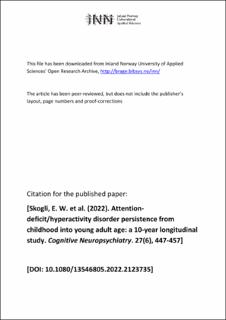Attention-deficit/hyperactivity disorder persistence from childhood into young adult age: a 10-year longitudinal study
Journal article, Peer reviewed, Preprint
Submitted version
Permanent lenke
https://hdl.handle.net/11250/3092276Utgivelsesdato
2022Metadata
Vis full innførselSamlinger
Sammendrag
Problems with executive function (EF) are considered a hallmark of Attention-Deficit/Hyperactivity Disorder (ADHD) and Autism Spectrum Disorder (ASD). However, little is known about the developmental pathway of everyday EF in these two groups, and whether the two groups follow a similar or different developmental course. In this longitudinal study, children and adolescents with ADHD (n = 84, Mage = 11.6, SD = 2.0), ASD (n = 38, Mage = 12.0, SD = 2.3), and typically developing children (TDC; n = 50, Mage = 11.6, SD = 2.0) were clinically diagnosed and assessed with parent-ratings of everyday EF at baseline and at two-year followup (97% retention). Results showed that both individuals with ADHD and individuals with ASD displayed elevated levels of everyday EF problems relative to the TDC at baseline (Hedges g = 1.99 to 2.99). Over the two-year period, everyday EF improved in individuals with ADHD relative to the TDC, whereas individuals with ASD displayed no improvement relative to the TDC. At two-year followup, individuals with ADHD and individuals with ASD continued to display elevated levels of everyday EF problems relative to the TDC (Hedges g = 1.61 to 3.19).
Beskrivelse
© 2022 Informa UK Limited, trading as Taylor & Francis Group.
